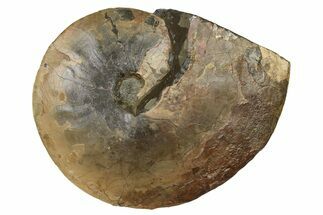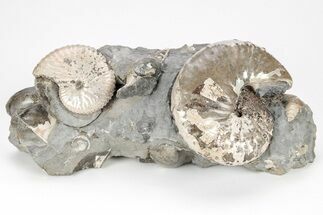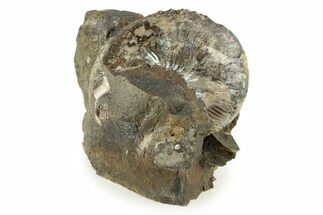This Specimen has been sold.
Huge, 12.5" Fossil Ammonite (Placenticeras) - South Dakota
This is a large ammonite (Placenticeras meeki) that was collected from the Fox Hills Formation of South Dakota. This ammonite was found broken and in some places fragmented requiring gap fill restoration, crack repair and significant stabilization. This stabilization is in the form of a thick epoxy coating on one side, while the opposite side has a thin glazing of epoxy. The remaining shell fragments have colorful iridescent properties.
Comes with a display stand.
Comes with a display stand.
These 70 million year old ammonites lived when South Dakota was a shallow inland sea. They were found preserved in concretions when split open. They then had to be hand-prepared to remove the hard rock surrounding them from their shells, a very time consuming task.
Ammonites were predatory cephalopod mollusks that resembled squids with spiral shells. They are more closely related to living octopuses, though their shells resemble that of nautilus species. True ammonites appeared in the fossil record about 240 million years ago during the Triassic Period. The last lineages disappeared 65 million years ago at the end of the Cretaceous.
SPECIES
Placenticeras meeki
LOCATION
South Dakota
FORMATION
Fox Hills Formation - Trail City Member
SIZE
12.5" Wide
CATEGORY
SUB CATEGORY
ITEM
#144026
We guarantee the authenticity of all of our
specimens. Read more about our
Authenticity Guarantee.
specimens. Read more about our
Authenticity Guarantee.
 Reviews
Reviews














